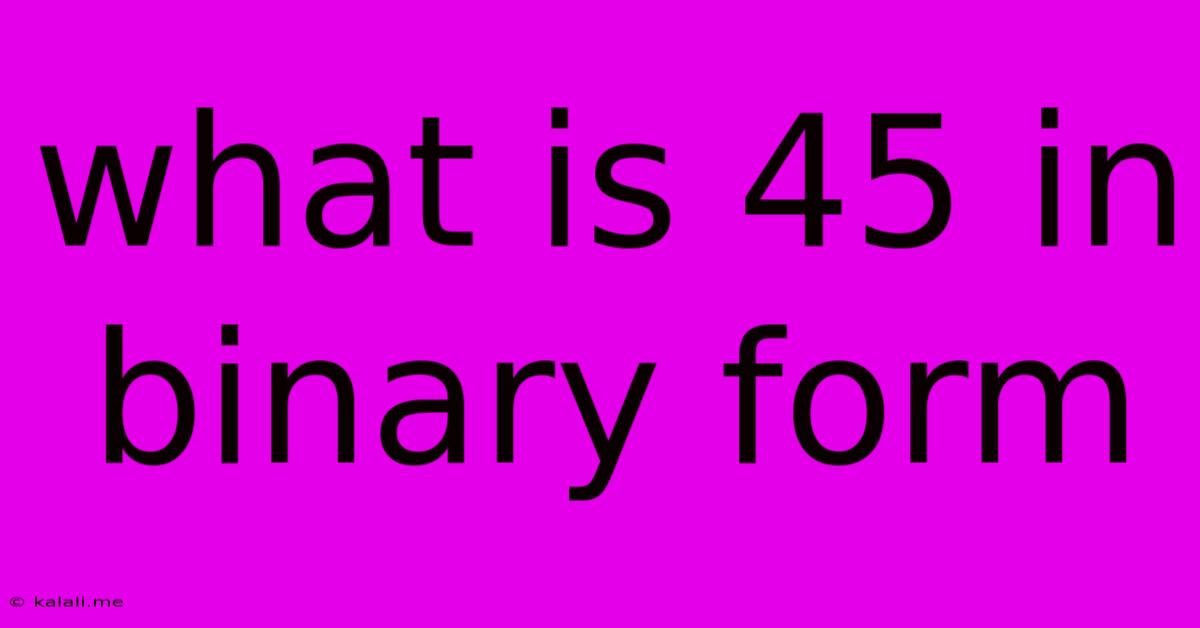What Is 45 In Binary Form
Kalali
Jun 12, 2025 · 3 min read

Table of Contents
What is 45 in Binary Form? A Beginner's Guide to Binary Conversion
Ever wondered how computers understand numbers? They don't use the decimal system (base-10) we're familiar with; instead, they use a binary system (base-2), which only uses two digits: 0 and 1. This article will guide you through the process of converting the decimal number 45 into its binary equivalent. Understanding this fundamental concept is crucial for anyone interested in computer science, programming, or digital electronics.
Understanding the Decimal and Binary Systems
Before diving into the conversion, let's briefly review the two number systems:
-
Decimal System (Base-10): This is the system we use every day. It uses ten digits (0-9) and each place value represents a power of 10 (ones, tens, hundreds, thousands, and so on).
-
Binary System (Base-2): This system uses only two digits, 0 and 1. Each place value represents a power of 2 (ones, twos, fours, eights, sixteens, thirty-twos, and so on).
Converting Decimal 45 to Binary
There are several methods to convert a decimal number to binary. Here's a common and straightforward approach:
-
Find the Largest Power of 2 Less Than or Equal to 45: The largest power of 2 less than 45 is 32 (2<sup>5</sup>). We'll start with this.
-
Subtract the Power of 2: Subtract 32 from 45: 45 - 32 = 13.
-
Repeat the Process: Now, find the largest power of 2 less than or equal to the remainder (13). That's 8 (2<sup>3</sup>).
-
Continue Subtracting: Subtract 8 from 13: 13 - 8 = 5.
-
Keep Going: The largest power of 2 less than or equal to 5 is 4 (2<sup>2</sup>). Subtract 4 from 5: 5 - 4 = 1.
-
Final Step: The largest power of 2 less than or equal to 1 is 1 (2<sup>0</sup>). Subtract 1 from 1: 1 - 1 = 0.
-
Construct the Binary Number: Now, let's list the powers of 2 we used and whether they were included (1) or not (0):
- 2<sup>5</sup> (32): 1
- 2<sup>4</sup> (16): 0
- 2<sup>3</sup> (8): 1
- 2<sup>2</sup> (4): 1
- 2<sup>1</sup> (2): 0
- 2<sup>0</sup> (1): 1
Therefore, the binary representation of 45 is 101101.
Verification:
Let's verify our answer:
(1 × 2<sup>5</sup>) + (0 × 2<sup>4</sup>) + (1 × 2<sup>3</sup>) + (1 × 2<sup>2</sup>) + (0 × 2<sup>1</sup>) + (1 × 2<sup>0</sup>) = 32 + 0 + 8 + 4 + 0 + 1 = 45
This confirms our conversion is correct.
Other Methods for Conversion
While the repeated subtraction method is easy to understand, other methods exist, such as the division method. However, for beginners, the repeated subtraction method provides a clear and intuitive understanding of the conversion process.
Understanding binary conversion is a fundamental skill in computer science. By mastering this process, you'll gain a deeper appreciation for how computers represent and manipulate data. This simple conversion from decimal 45 to binary 101101 is a stepping stone to more complex concepts in digital logic and computer architecture.
Latest Posts
Latest Posts
-
What Is The Factor Of 71
Jun 13, 2025
-
10 Is 30 Of What Number
Jun 13, 2025
-
Florida A And M Acceptance Rate
Jun 13, 2025
-
Who Identified Triads Of Elements With Similar Properties
Jun 13, 2025
-
What Is The Boiling Point On The Fahrenheit Scale
Jun 13, 2025
Related Post
Thank you for visiting our website which covers about What Is 45 In Binary Form . We hope the information provided has been useful to you. Feel free to contact us if you have any questions or need further assistance. See you next time and don't miss to bookmark.